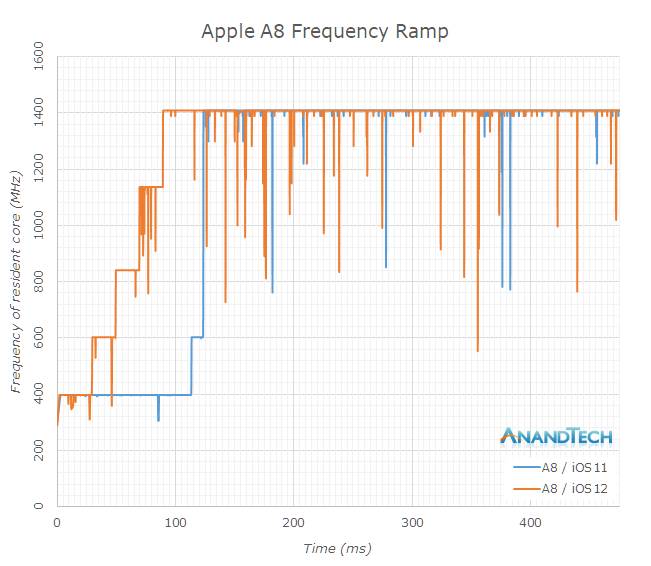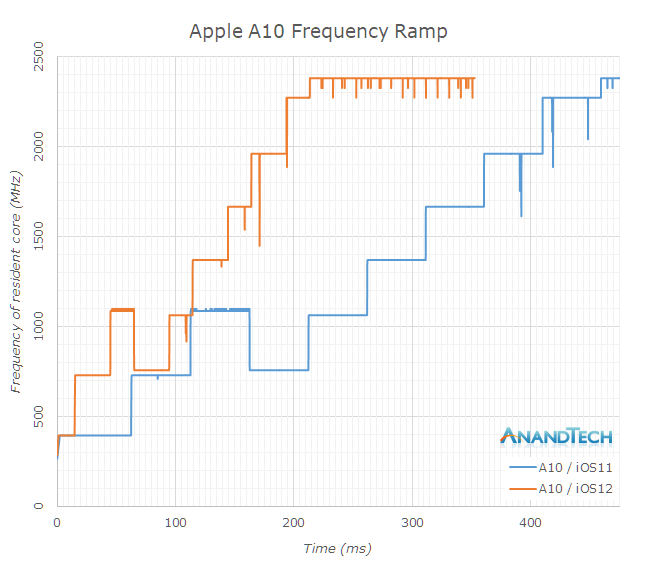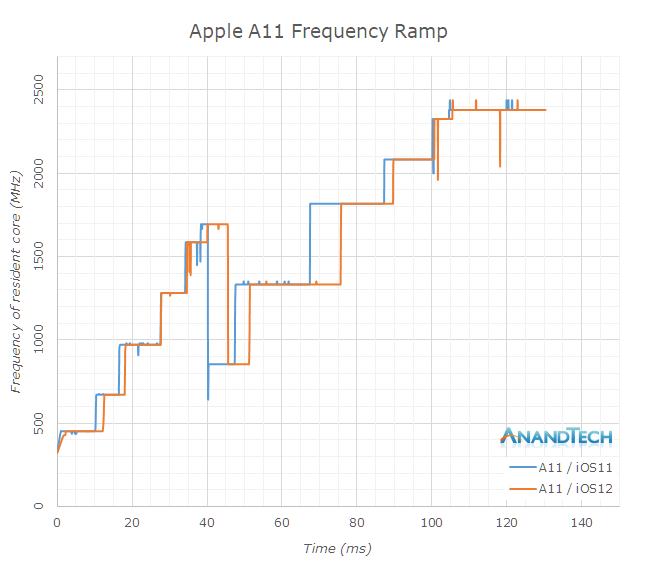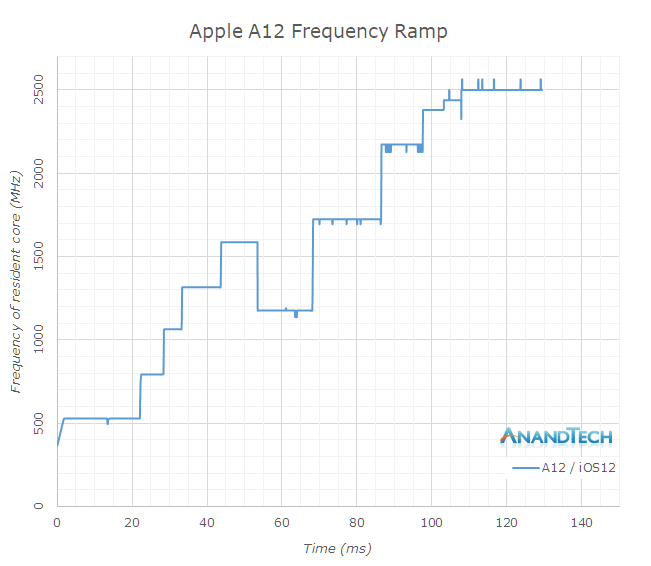The iPhone XS & XS Max Review: Unveiling the Silicon Secrets
by Andrei Frumusanu on October 5, 2018 8:00 AM EST- Posted in
- Mobile
- Apple
- Smartphones
- iPhone XS
- iPhone XS Max
System Performance
While synthetic test performance is one thing, and hopefully we’ve covered that well with SPEC, interactive performance in real use-cases behaves differently, and here software can play a major role in terms of the perceived performance.
I will openly admit that our iOS system performance suite looks extremely meager: we are only really left with our web browser tests, as iOS is quite lacking in meaningful alternatives such as to PCMark on the Android side.

Speedometer 2.0 is the most up-to-date industry standard JavaScript benchmark which tests the most common and modern JS framework performance.
The A12 sports a massive jump of 31% over the A11, again pointing out that Apple’s advertised performance figures are quite underselling the new chipset.
We’re also seeing a small boost from iOS 12 on the previous generation devices. Here the boost comes not only thanks to an a change in how iOS’s scheduler handles load, but also thanks to further improvements in the ever evolving JS engine that Apple uses.

WebXPRT 3 is also a browser test, however its workloads are more wide-spread and varied, containing also a lot of processing tests. Here the iPhone XS showcases a smaller 11% advantage over the iPhone X.
Former devices here also see a healthy boost in performance, with the iPhone X ticking up from 134 to 147 points, or 10%. The iPhone 7’s A10 sees a larger boost of 33%, something we’ll get into more detail in a little bit.
iOS12 Scheduler Load Ramp Analyzed
Apple promised a significant performance improvement in iOS12, thanks to the way their new scheduler is accounting for the loads from individual tasks. The operating system’s kernel scheduler tracks execution time of threads, and aggregates this into an utilisation metric which is then used by for example the DVFS mechanism. The algorithm which decides on how this load is accounted over time is generally simple a software decision – and it can be tweaked and engineered to whatever a vendor sees fit.
Because iOS’s kernel is closed source, we’re can’t really see what the changes are, however we can measure their effects. A relatively simple way to do this is to track frequency over time in a workload from idle, to full performance. I did this on a set of iPhones ranging from the 6 to the X (and XS), before and after the iOS12 system update.
Starting off with the iPhone 6 with the A8 chipset, I had some odd results on iOS11 as the scaling behaviour from idle to full performance was quite unusual. I repeated this a few times yet it still came up with the same results. The A8’s CPU’s idled at 400MHz, and remained here for 110ms until it jumped to 600MHz and then again 10ms later went on to the full 1400MHz of the cores.
iOS12 showcased a more step-wise behaviour, scaling up earlier and also reaching full performance after 90ms.
The iPhone 6S had a significantly different scaling behaviour on iOS11, and the A9 chip’s DVFS was insanely slow. Here it took a total of 435ms for the CPU to reach its maximum frequency. With the iOS12 update, this time has been massively slashed down to 80ms, giving a great boost to performance in shorter interactive workloads.
I was quite astonished to see just how slow the scheduler was before – this is currently the very same issue that is handicapping Samsung’s Exynos chipsets and maybe other Android SoCs who don’t optimise their schedulers. While the hardware performance might be there, it just doesn’t manifest itself in short interactive workloads because the scheduler load tracking algorithm is just too slow.
The A10 had similar bad characteristics as the A9, with time to full performance well exceeding 400ms. In iOS12, the iPhone 7 slashes this roughly in half, to around 210ms. It’s odd to see the A10 being more conservative in this regard compared to the A9 – but this might have something to do with the little cores.
In this graph, it’s also notable to see the frequency of the small cores Zephyr cores – they start at 400MHz and peak at 1100MHz. The frequency in the graph goes down back to 758MHz because at this point there was a core switch over to the big cores, which continue their frequency ramp up until maximum performance.
On the Apple A11 – I didn’t see any major changes, and indeed any differences could just be random noise between measuring on the different firmwares. Both in iOS11 and iOS12, the A11 scales to full frequency in about 105ms. Please note the x-axis in this graph is a lot shorter than previous graphs.
Finally on the iPhone XS’s A12 chipset, we can’t measure any pre- and post- update as the phone comes with iOS12 out of the box. Here again we see that it reaches full performance after 108ms, and we see the transition of the tread from the Tempest cores over to the Vortex cores.
Overall, I hope this is the best and clear visual representation of the performance differences that iOS12 brings to older devices.
In terms of the iPhone XS – I haven’t had any issues at all with performance of the phone and it was fast. I have to admit I’m still a daily Android user, and I use my phones with animations completely turned off as I find they get in the way of the speed of a device. There’s no way to completely turn animation off in iOS, and while this is just my subjective personal opinion, I found they are quite hampering the true performance of the phone. In workloads that are not interactive, the iPhone XS just blazed through them without any issue or concern.















253 Comments
View All Comments
Constructor - Monday, October 8, 2018 - link
Sure you can – just go to airplane mode and re-enable WiFi.s.yu - Monday, October 8, 2018 - link
In the third and fifth low light sample I think it's pretty clear that the XS beat the P20P, again P20P's retention of texture is horrible and only in extreme low light (second and last sample) and scenes with many man-made objects which lack obvious texture (third sample) does its excessive sharpening and NR have a advantage. The first sample is a surprise, there either the scene is actually darker than I'm lead to believe or there's something else I've not taken into account.daiquiri - Monday, October 8, 2018 - link
Isn't this a too bold affirmation that A12 is on par with current desktop CPUs? So why didn't we stack them in order to have 5x the processing power of a common laptop/workstation for 1/2 of the power? What am I missing here? Because this doesn't make much sense to me.If I have 2 or 3 of these SoC chips and photoshop running on them will I have my filters running faster? Chrome loading webpages faster? Creating zip archives or converting flac files 3x times faster than an Intel I7?
resiroth - Monday, October 8, 2018 - link
There is widespread speculation (and at this point, it is considered more likely than not) that apple will transition to their own chips exclusively for their Mac products in the near future (within 2 years).What exactly doesn’t make sense to you?
Ps: will be very interesting to see results of new iPad Pro this year too.
daiquiri - Monday, October 8, 2018 - link
What is strange to me is why aren't we already stacking this SoCs. I suppose I can fit 6 or 8 of these processors on the same die size. This means I would have a lot faster PC for less power? It they are that great why aren't on desktops already?Does this mean if I manage to install Windows 10 ARM edition on my PC photoshop will run faster and Chrome will load pages two or three times faster since I have 8 of these SoCs on my desktop pc?
Constructor - Wednesday, October 10, 2018 - link
Because just increasing the core count is not quite enough.As I have explained above, a platform transition is a massive undertaking which among many other things needs actually superior performance to afford the initially still necessary legacy code emulation.
This will almost certainly start at a WWDC (next year or the year after that, most likely) with an announcement about not just coming hardware but also about those new mechanisms in macOS itself, and actual Axx-powered Macs may take months after that to emerge while developers start porting their code to the new platform.
It's not as if this was the first time for Apple – they've done it twice already!
varase - Tuesday, October 23, 2018 - link
Yeah, but they always went to a *much* faster CPU to do the emulation.Constructor - Wednesday, October 24, 2018 - link
Even just the iPhone cores right now are already at about a desktop i5 level according to GeekBench.There should be quite some room for upscaling with more power and better cooling.
tipoo - Wednesday, October 24, 2018 - link
These cores are 30% larger than Intels, let that sink in.I'm sure 8 of them would perform marvellously, for the cost. And it may be coming.
Zoolook - Tuesday, October 9, 2018 - link
I just pulled an old test of a i3-6320, a 3 year old dual-core, and the A12 does good on some of the tests, but in many tests it's quite a bit behind, so it's not ready for server-duty yet.I know that the i3 has higher frequencies but it's also only two cores, compared to 2+4.
There is no question that the big cores are very efficient, but they are optimized for their current job.
If Apple would build a 6- or 8-core processor based on their large cores and throw away most of the other SoC and add other parts (stronger SIMD etc), yes then we might have a good desktop/serverchip, but the A12 is not that chip.
Also remember that we are comparing 14nm Intel chips with the newest "7nm" process, if Intel ever gets their 10nm process up and running for real, then we could do a better comparison.